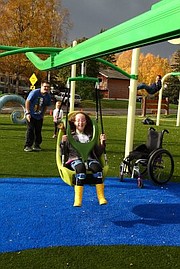Inclusive park in the works
SANDPOINT — Imagine a playground where your daughter with autism has access to a slide designed to accommodate sensory issues, or a handicapped friend has a swing he can enjoy alongside your son.
This vision for an inclusive playground is a possibility for Sandpoint as the city navigates options for an upgraded playground at Travers Park, made possible by a Land and Water Conservation Fund grant. During an Oct. 18 council meeting, city staff and a consultant gave a presentation on how the grant could be used for a new play structure and splashpad. With help from the public through engagement opportunities, the city hopes to create an area that accommodates all abilities and disabilities.
The inspiration for the new playground will be drawn from “Sandpoint stories” and “Into the Woods,” Maeve Nevins-Lavtar, the city’s Parks Planning and Development manager, said. This theme was generated by the community to reflect the friendship that tied the Russell family, whose donation is contributing to upgrades at Travers Park, to Patrick McManus, she told those gathered.
Nevins-Lavtar said being truly inclusive means “a playground designed with everyone in mind.” She has worked with establishing other inclusive playgrounds, including 13 projects in Anchorage, Alaska. She also said she is inspired by her own ties to disabilities.
“I've built my career around inclusivity,” she said. “My mother is disabled, I'm deaf in my left ear, but I had a surgery that replaced a bone, so I have an invisible disability.”
Often it seems like a ramp might be enough to create an inclusive play environment, but challenges for some children range beyond features addressed by ADA compliance laws. An inclusive playground has something for everyone.
“It is accessible, has various levels of challenge for all users, and most importantly, fun.” Nevins-Lavtar said. “There are seven physical, sensory and social play opportunities that I aim to include in each of the playground projects. Those include, but may not be limited to: swinging, spinning, sliding, rocking, nooks, climbing and auditory or musical play.”
While some playgrounds offer segregated opportunities where equipment for children with different abilities is set apart, or integrated opportunities, like one swing that could accommodate a child under 5 among many others, this new playground will bring everyone into the same space, Nevins-Lavtar said.
“This grant could make it so that we can all play together,” she said. “... What I am talking about, and I have been for over two years, is inclusion — and that means all ages, all abilities.
In May, a company named Landscape Structures sponsored an informational workshop in Sandpoint called “Inclusive Play Lunch & Learn.” Their website surveys the features of a playground that welcomes everyone.
“A truly inclusive playground doesn’t have areas off to the side for children with disabilities, or designated spaces for special needs playground equipment,” their website said. “Inclusive means everyone is a part of play with peers of all abilities. Inclusive playgrounds create an atmosphere where everyone can interact with each other, explore, imagine and play together.”
While inclusivity takes the park a step further than ADA compliance, there are still updates that will be necessary to keep the park up to code.
“Playground equipment and facilities constructed or altered on or after March 15, 2012, must comply with the 2010 ADA Standards for Accessible Design,” the National Program for Playground Safety website said.
This includes, but is not limited to, accessible surfacing, and accessibility from a mobility device.
“Once a child is in the play area, they must be able to access the play equipment by either moving out of their mobility device onto the playground structure (such as a transfer station) or by direct play structure access in their mobility device (such as a ramp),” the website said.
Every project begins with data informed analysis to determine the specific needs of a community, Nevins-Lavtar said.
“The next step is to conduct public outreach that informs the design and equipment,” she continued. “For the Travers Park inclusive playground and splash pad, the design team will be hosting a series of public engagement opportunities with a focus on the children’s desires for the space and the equipment,” Nevins-Lavtar said. “That project has not yet started, but please stay in touch as this evolves because it truly is a fun experience for all.”
Based on public comment, Nevins-Lavtar said the city also plans to reuse existing play equipment.
“Not only are we using the existing playground and all the pieces that we can possibly refurbish, because we heard the community loud and clear through … nine public meetings here on top of our public outreach meeting,” she said. “We have really crafted our way through this, intimately getting familiar with what is on site. And we are reusing that equipment to build the ‘new, old playground,’ if you will.”
Mike Terrell, the city’s consultant for the project, gave a presentation at the council meeting addressing the design process of the playground.
“We want (the playground) to reflect the community in the best way possible,” Terrell said during his presentation to the council. “One of the things we do is we have children's design workshops and we have it set up where they can draw ‘my dream playground,’ or model their dream playground out of playdough.”
The Land and Water Conservation Fund grant that will pay for the park totals $1,122,336, with grant funds totaling $561,168 and city required match funds in the amount of $561,168.
The city council voted unanimously to accept the grant at the end of its Oct. 18 meeting.
“Hopefully, this time next year, we'll be talking about a ribbon cutting,” Terrell said.



